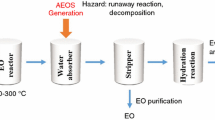Abstract
The thermal polymerization of inhibited styrene monomer is investigated by Accelerating Rate Calorimetry (ARC). The time-temperature-pressure data generated by this technique are utilized in evaluating the thermal hazards associated with the industrial processing of styrene monomer. Several examples are given on the interpretation and application of ARC data to environments ranging from lab to plant-scale conditions including discussions concerning the similarities and dissimilarities between the ARC and large-scale equipment. The polymerization of styrene monomer is also used to evaluate the performance of the ARC over a broad temperature range, 80–300°C. The data indicate that removal of the radiant heater assembly yields better agreement between the heat of polymerization of styrene as measured by the ARC and corresponding values from the literature. This effect is believed to be observable only under conditions of low reaction rates for long periods of time such as in the case of styrene monomer.
Zusammenfassung
Die thermische Polymerisation eines gehemmten Styrolmonomers wurde durch Accelerating Rate Calorimetry (ARC) untersucht. Die durch diese Technik erhaltenen Zeit-Temperatur-Druck-Daten wurden zur Bewertung der mit der industriellen Herstellung von Styrolmonomeren verbundenen thermischen Gefahren verwendet-. Mehrere Beispiele über Deutung und Einsatz von ARC-Daten unter Laboratoriumsbis zu Versuchsbetriebsbedingungen werden gegeben, einschließlich Erörterungen hinsichtlich der Ähnlichkeiten und Unterschiede zwischen ARC und betriebsgemäßen Vorrichtungen. Die Polymerisation des Styrolmonomers wird auch zur Bewertung der Leistung von ARC in einem weiten Temperaturbereich, von 80 bis 300° eingesetzt. Die Daten zeigen, daß die Entfernung der Strahlungsheizvorrichtung eine bessere Übereinstimmung zwischen den durch ARC gemessenen und in der Literatur vorhandenen Werten der Polymerisationswärme von Styrol ergibt. Es wird angenommen, daß dieser Effekt nur unter Bedingungen niedriger Reaktionsgeschwindigkeiten während längerer Zeiträume, wie im Falle des Styrolmonomers, beobachtet werden kann.
Резюме
С помощью калориметр ии с возростающей скоростью исследова на термическая полимеризация ингиб ированного стирола. П олученные этим методом данные в ремя-температура-дав ление, использованы для опр еделения факторов термическо й опасности при промышленной перера ботке стирола. Предст авлено несколько примеров и нтерпретации и применения этого мет ода в окружающей обст ановке от лабораторных услови й до промышленных масштабов, включая об суждение подобий и различий между обору дованием для калориметрии с возро стающей скоростью и крупномасштабным об орудованием. Полимер изация стирола использован а для оценки действенности этого метода в области темп ератур 80–300°. Опыты показали, чт о удаление источника теплового излучения приводит к лучшему согласию ме жду теплотой полимер изации стирола, измеренной э тим методом и соответствующими ли тературными данными. Считается, что этот эффект будет наблюдаем только для случая низ ких констант скорост ей в течении длительного периода времени, как это имеет место в случ ае стирола.
Similar content being viewed by others
Abbreviations
- α :
-
sample adiabaticity
- q s, t :
-
heat retention rate of sample
- q T, t :
-
total rate of heat generation of sample
- M s :
-
sample mass
- M b :
-
sample container mass
- C vs :
-
specific heat of sample at constant volume
- C vb :
-
specific heat of sample container at constant volume
- Φ :
-
thermal inertia
- T 0 :
-
initial temperature of exotherm
- T f, s :
-
final temperature of exotherm
- T av :
-
average temperature during exotherm
- ΔT AB, s :
-
experimental temperature rise
- ΔT AB :
-
adiabatic temperature rise of sample
- ΔE v :
-
change in internal energy at constant volume
- Q v :
-
total heat generated by sample at constant volume
- ΔH v :
-
change in enthalpy at constant volume
- P :
-
pressure
- V :
-
volume
- C :
-
concentration
- C 0 :
-
initial concentration
- x :
-
fraction reacted
References
A. A. Duswalt, Thermochim. Acta, 8 (1974) 57.
J. C. Tou andL. F. Whiting, Thermochim. Acta, 42 (1980) 21.
J.Hakl, Tenth North American Thermal Analysis Society Conference, Boston, Mass, Oct. 26–29, 1980.
W.Regenass, ACS Symposium Series, Eds V. W. Weekman and D. Luss, No. 65, Chemical Reaction Engineering, Houston, 1978, p. 37.
L.Walker, The Fifth International Conference on Chemical Thermodynamics, Aug. 1977, Ronneby, Sweden.
G. W. Harmon andH. A. Martin, Loss Prevention Symposium, Part IV, Pressure Vessels, American Institute of Chemical Engineers, 67th National Meeting, Atlanta, Georgia, 1970, pp. 1–30.
D. I. Townsend andJ. C. Tou, Thermochim. Acta, 37 (1980) 1–30.
D. W.Smith, M. C.Taylor, R.Young, and T.Stevens, Amer. Lab., June, 1980.
J. C. Tou andL. F. Whiting, Thermochim. Acta, 48 (1981) 21.
D. R. Stull, Styrene, Its Polymers, Copolymers, and Derivatives, Eds R. H. Boundy and R. F. Boyer, Reinhold Publishing Corp., New York, 1952, pp. 68–69.
C. Y.Ho, P. D.Desai, K. Y.Wu, T. N.Havill and T. Y.Lee, Proc. 7th Symposium on Thermophysical Properties, ASME/NBS, 1977, pp. 198–218.
A. E.Platt, Encyclopedia of Polymer Science and Technology, Vol. 13, John Wiley and Sons, 1970, pp. 156–159.
D. R.Stull,op. cit., pp. 77–78.
Accelerating Rate Calorimeter Operating Manual for Model 509 Series, Columbia Scientific Industries, Austin, Texas.
Author information
Authors and Affiliations
Additional information
The authors express their appreciation to Harold Raykovitz for running the ARC tests, to Dick Solem for supplying the thin-wall nickel bombs along with helpful comments on instrument performance, to Jim Huff for his development of the concept of “adiabaticity” for data scale-up, detailed discussions on styrene runaways and data on specific heats of materials used in this study, to Alan Platt and Henry Karam for general information on styrene polymerizations and associated thermodynamics, to Maurice Peacock for his analyses on the molecular weight distribution of the polystyrene and residual monomers, dimers, and trimers, to George Crable for his many helpful comments on the experimental results, and to D. Townsend, H. Kohlbrand and Ken First for their careful review of the manuscript.
Rights and permissions
About this article
Cite this article
Whiting, L.F., Tou, J.C. Thermal hazard evaluation of styrene polymerization by accelerating rate calorimetry. Journal of Thermal Analysis 24, 111–132 (1982). https://doi.org/10.1007/BF01914806
Received:
Issue Date:
DOI: https://doi.org/10.1007/BF01914806




